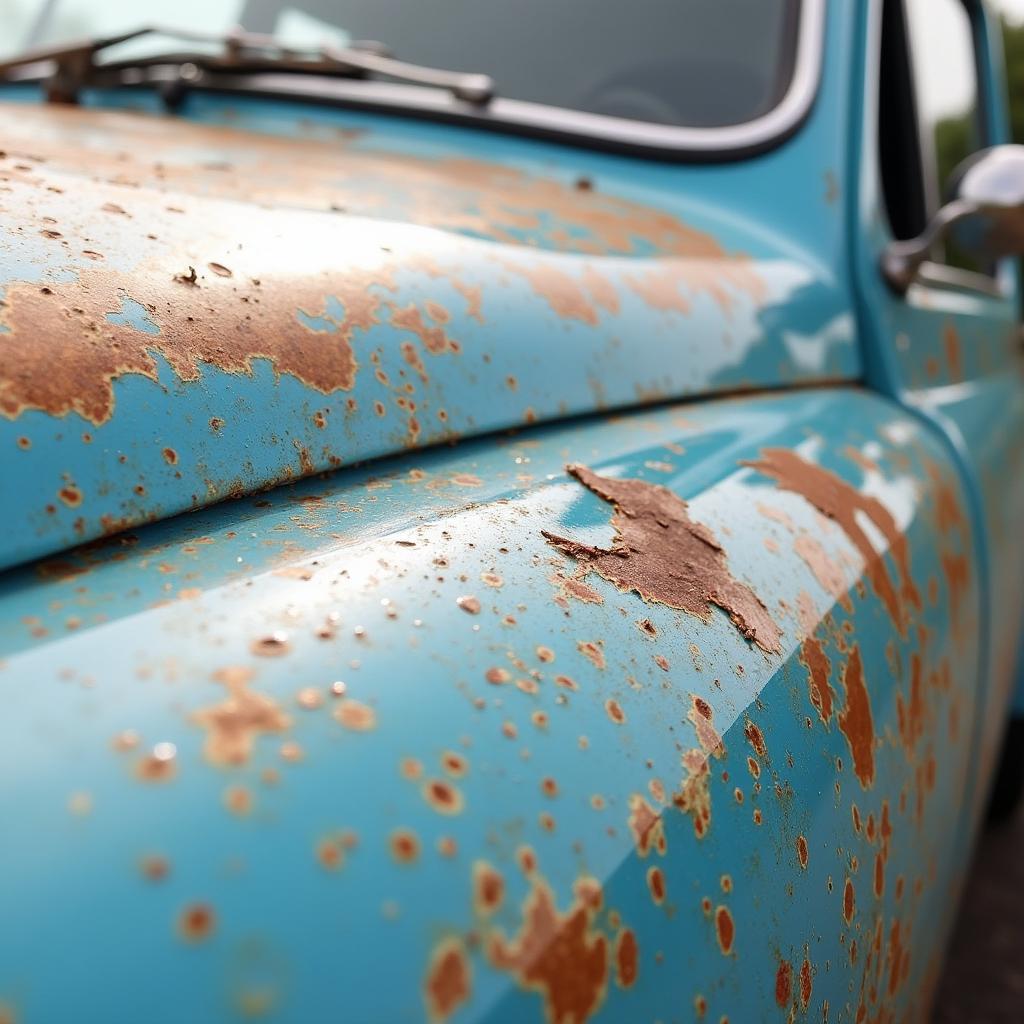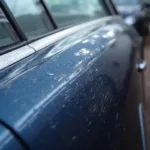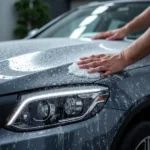Peeling car paint can be a real eyesore, diminishing the aesthetic appeal of your vehicle and potentially leading to further damage. But before you panic, know that addressing this issue is possible, even for those without extensive automotive experience. This comprehensive guide will take you through the steps to repair peeling paint, helping you restore your car’s finish and protect it from future damage.
Understanding the Causes of Peeling Car Paint
Before diving into the repair process, it’s essential to understand the culprits behind peeling paint. Identifying the root cause can help you address the issue effectively and prevent it from reoccurring.
Here are some common reasons why car paint peels:
- UV Damage: Prolonged exposure to the sun’s harmful ultraviolet rays can cause the paint to oxidize, leading to fading, cracking, and peeling.
- Moisture: When moisture seeps beneath the paint layers, it can weaken their bond with the metal, resulting in bubbling and peeling. This is particularly common in areas with high humidity or frequent rainfall.
- Poor Paint Job: A rushed or improperly executed paint job can lead to inadequate adhesion between paint layers, making it susceptible to peeling.
- Chemical Exposure: Contact with harsh chemicals, such as road salt, bird droppings, or cleaning agents, can strip away the paint’s protective layer and cause damage.
- Impact Damage: Chips from rocks, debris, or minor accidents can create openings for moisture and other elements to penetrate, initiating the peeling process.
Essential Tools and Materials
Gather the necessary tools and materials before you begin the repair process:
- Car Wash Supplies: Soap, water, sponge, microfiber towels
- Sandpaper: Various grits (220, 320, 400, 600)
- Masking Tape and Paper: To protect surrounding areas
- Primer: Designed for automotive use
- Automotive Paint: Matching your car’s color
- Clear Coat: For a glossy and protective finish
- Paintbrushes, Rollers, or Spray Gun: Depending on your preference and skill level
- Safety Gear: Gloves, safety glasses, and a respirator
Step-by-Step Guide to Repairing Peeling Car Paint
Now, let’s get down to the nitty-gritty of repairing that pesky peeling paint:
-
Clean the Affected Area: Thoroughly wash the car, paying extra attention to the peeling paint section. Use soap specifically designed for automotive finishes and a soft sponge to avoid further scratching. Rinse well and dry completely with a microfiber towel.
-
Sand the Damaged Paint: Using 220-grit sandpaper, sand the peeling paint edges until you reach a smooth, even surface transition between the damaged and undamaged areas. Gradually move to finer grits (320, 400) to feather the edges and create a smooth base for the new paint.
-
Mask Off the Surrounding Area: Use masking tape and paper to protect the surrounding areas from overspray or accidental paint drips. Ensure a clean and secure seal to prevent any paint from bleeding through.
-
Prime the Sanded Area: Apply a thin, even coat of automotive primer to the sanded area. Primer promotes adhesion of the new paint and helps to create a uniform surface. Allow the primer to dry completely according to the manufacturer’s instructions.
-
Apply Automotive Paint: Once the primer dries, apply thin, even coats of automotive paint matching your car’s color. Use a paintbrush, roller, or spray gun, depending on your preference and the size of the repair area. Allow each coat to dry thoroughly before applying the next.
-
Apply Clear Coat: After the final coat of paint dries, apply two to three layers of clear coat. Clear coat provides a glossy finish and protects the paint from UV rays, scratches, and other environmental damage.
-
Remove Masking and Let it Cure: After the final coat of clear coat dries, carefully remove the masking tape and paper. Allow the newly painted area to cure completely, typically for 24-48 hours, before washing or waxing.
Tips for a Professional-Looking Finish
- Proper Ventilation: Ensure adequate ventilation when working with paints and primers.
- Thin Coats: Apply multiple thin coats instead of one thick coat for a smoother finish and better adhesion.
- Wet Sanding: For a professional-level shine, consider wet sanding the clear coat with ultra-fine grit sandpaper (1000-2000) and polishing compound.
When to Seek Professional Help
While DIY paint repair can be effective for minor peeling, it’s best to consult a professional for extensive damage or if you’re uncomfortable with the process. How to repair peeling car paint can be tricky, and a professional can ensure a high-quality, long-lasting repair.
Preventing Future Paint Peeling
Prevention is always better than cure. Here are some proactive measures to keep your car’s paint job looking pristine:
- Regular Washing: Regularly wash your car to remove dirt, grime, and contaminants that can damage the paint.
- Waxing: Apply a layer of wax every few months to protect the paint from UV damage and other environmental factors.
- Covered Parking: Whenever possible, park your car in a garage or under a car cover to shield it from the elements.
- Prompt Repair of Chips and Scratches: Address any paint chips or scratches promptly to prevent moisture and other elements from penetrating the paint layers.
Conclusion
Peeling car paint, while unsightly, is a manageable issue. By following the steps outlined in this guide, you can successfully repair the damage and restore your car’s appearance. Remember to prioritize prevention by adhering to regular maintenance practices, protecting your vehicle from the elements, and promptly addressing any paint imperfections. With a bit of effort, you can keep your car looking its best for years to come.
FAQs
Q: Can I use regular spray paint on my car?
A: It’s not recommended. Automotive paint is specifically designed to withstand the rigors of weather, UV rays, and other environmental factors that regular spray paint cannot handle.
Q: How long does it take for car paint to cure completely?
A: While the paint may feel dry to the touch within a few hours, it typically takes 24-48 hours for it to cure completely. During this time, avoid washing or waxing the car.
Q: Can I apply a clear coat over old, faded paint?
A: Applying a clear coat over old, faded paint may temporarily improve its appearance, but it won’t address the underlying issue.
Q: What is car paint lacquer peeling repair?
A: Car paint lacquer peeling repair refers to fixing peeling on the clear coat layer, which protects the base coat and provides shine.
Q: How much does it cost to fix a small paint chip on a car?
A: For information on [small car paint chip repair](https://carrepairon.com/small-car paint-chip-repair/) costs, refer to our detailed guide on our website. The price can vary depending on factors like the chip’s size, location, and your car’s make and model.
If you need help understanding the average price of car paint repair, our team is always here to assist you.
Seeking Professional Car Paint Repair in Guelph?
For expert car paint repair in Guelph, look no further than CarRepairOnline. We are your trusted source for all your automotive repair needs.
Need help with car paint repair or have other automotive questions? Contact us today via WhatsApp: +1(641)206-8880, or Email: [email protected]. Our dedicated team is available 24/7 to assist you.



